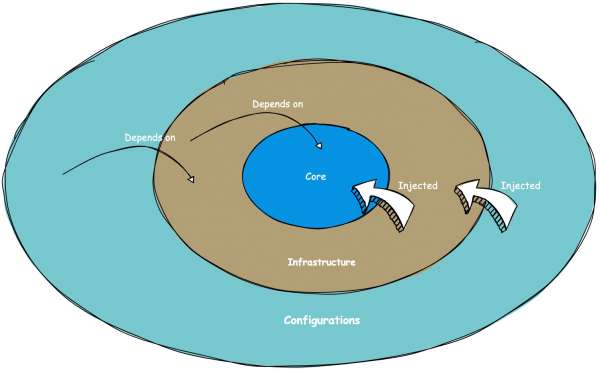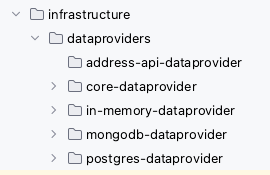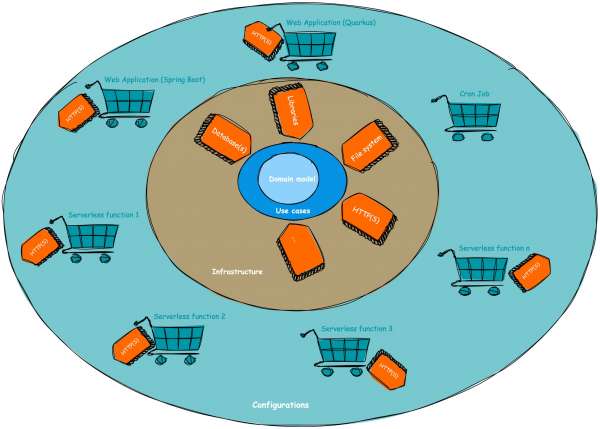The purpose of this project is to provide developers with a practical example of how clean architecture can be implemented in a real-world scenario. By examining this sample project's code and structure, you will be able to better understand the key concepts and patterns involved in clean architecture.
Why clean architecture?
These days, the IT world is flooded with an overwhelming number of libraries, technologies, frameworks, and platforms to choose from. What's considered the ultimate solution today may become outdated tomorrow. What doesn't exist today might become tomorrow's ultimate solution. Clean architecture incorporates principles like SOLID and domain-driven design and enforces them through module structuring during compilation. However, it's important to note that not everything can be enforced at compile time.
By embracing clean architecture principles, you can design software without getting tied down to specific libraries, infrastructure, or other choices right from the start of your project. Instead, you can postpone those decisions until later in the development process. This approach also makes it easier to switch libraries or infrastructure if needed, enabling you to create software that can stand the test of time. With clean architecture, you can keep your options open and ensure that your platform or application remains robust and adaptable in the long run.
Real-world analogies
If you're in the lead of a football team, you better not offer long-term contracts to a new coach (maybe this is an exaggeration), because in 90% of the cases, a coach doesn't last for more than two years. Offering short-term contracts lets the team change trainers as often as needed to achieve good results.
As a business analogy, companies that do not focus on software development (e.g., companies with a focus on biochemistry) often rely on consultancy companies. Again, to keep options open. When they need more software developers, want to change software developers (e.g., mismatch with the atmosphere within the team), or just want to decrease the number of developers (e.g., wrapping up of a project), then they are more flexible to do so when dealing with consultants than when they'd be dealing with internal employees.
Clean architecture: My interpretation
The clean architecture concepts discussed in this article are based on Clean Architecture: A Craftsman's Guide to Software Structure and Design by Robert Martin. I highly recommend reading the book, as it provides a comprehensive understanding of these concepts.
This repository serves as a condensed summary of the main ideas and includes a Kotlin implementation example. I've designed this setup to facilitate easy evaluation and comparison between Spring Boot and Quarkus and demonstrate the process of extracting microservices or serverless functions from a monolithic application. In the following section, I'll share my perspective on clean architecture and apply it to the example project located in the /application directory.
To summarize clean architecture, it's about keeping your options open and minimizing regression risks. When I say "keeping your options open," I mean that you can definitely be fond of a library, database technology, or any other component, but you shouldn't commit to it for life. You should have the flexibility to easily swap, add, or remove libraries, databases, and other infrastructure elements.
Limiting regression risks
Now, let's talk about reducing regression risks. Clean architecture introduces the concept of use cases instead of services. Depending on the actual implementation, this might seem like a slight violation of the "don't repeat yourself" (DRY) principle because code is isolated based on user actions.
For instance, instead of having a person service with methods like "create person," "update email," and "change address" (which might share some private methods), we create separate classes like CreatePersonUseCase, UpdatePersonEmailUseCase, and ChangePersonAddressUseCase without code reuse.
This might seem like overkill, but this approach has its advantages in more complex scenarios. It limits the risk of regression to the specific user actions you're working on. Modifying the CreatePersonUseCase won't impact the UpdatePersonEmailUseCase, reducing the chances of unexpected regression.
Remember, any code you touch can potentially break. Clean architecture enforces this idea by moving away from the traditional lasagna-layered approach of service-oriented architecture (controller layer, service layer, database layer) and embracing an onion-layered approach, as illustrated in Figure 1.

Core layer
Let's dive into the first layer, the heart of the application stack: the core layer. Sometimes, this layer is even divided into two parts: the domain (which includes data classes and plain old Java objects, or POJOs) and the use cases (which house the business logic). This layer holds all the essential business logic and follows a crucial rule: it should not rely on any external libraries or dependencies, whether they're developed internally or externally.
The only allowed dependency here is the programming language itself (in our case, Kotlin). If you're working with plain Java, there's one library that can be up for discussion: Lombok. Since Lombok generates classes at compile time, it can be permitted in the core layer. If needed, you can easily remove it by replacing the annotated classes with the generated ones.
But does this mean you can't ever use external libraries? Not at all! In fact, you should embrace them (no need to reinvent the wheel), but they should be injected into the core layer through interfaces. The same rules apply to database access and other infrastructure-related code: no implementations should reside in the core layer, only interfaces for injection.
Here's an important point: although Java and Kotlin natively support file-based access, it should not be part of the core layer. Instead, it should be injected via interfaces from an infrastructure module.
Lastly, there's a crucial rule that I believe holds significance: changes in clean architecture should only propagate from the inner layers to the outer layers, not the other way around. In other words, a change in the infrastructure layer should never trigger a change in the core layer (see Figure 2).

Domain
This module houses the data classes, encompassing both the write and read models. However, it's also possible to have only the write model in this module and define the read model at the controller level (in the configuration layer). In such cases, you can map the read model using presenters. Personally, because I also retrieve data through use cases (security validation is, for me, a part of the core layer), I prefer to have both the write and read models in the domain layer.
UseCases
UseCase classes encapsulate the core business logic and can be aligned with the concept of "commands" in domain-driven design. By making the business logic independent of infrastructure and dependencies, we ensure its resilience over time. The layered structure surrounding the core logic, as demonstrated in the example application, makes it relatively straightforward to modify infrastructural components or libraries without the need to modify the core/business logic. This approach reduces the hesitation to make changes and encourages innovation.
In this section, we come across a discussion point regarding handling read operations. One option is to wire repositories directly into (e.g., REST) controllers and map them to read models using presenters. However, I prefer implementing read operations through use cases as well. This allows for implementing aggregations or incorporating security within the core layer. Thus, the domain layer contains both read and write data models, and the use cases cover operations such as creation, editing, deletion, and reading.
Another principle I adhere to in the use case layer is naming any interface that provides data as a "repository," even if the actual implementation is HTTP-based, such as REST. This approach avoids implicitly introducing infrastructure logic into the core layer. For instance, when extracting a microservice from a monolith, a core interface would be renamed from "xRepository" to "xClient." I believe that changes in the core layer should be avoided when modifying infrastructure, and therefore, any data provider is considered a "repository" in my approach.
Infrastructure layer
In the infrastructure layer, we handle the implementation of connections with various infrastructural components, as the name suggests. Typically, we organize this layer into submodules based on different technologies or components. This modular approach simplifies the process of performing updates, making changes, or replacing specific components.
dataproviders
The dataproviders layer primarily focuses on mapping database access. However, it can also encompass API access. For instance, if you're calling a REST API of another service, that would also fall under the dataproviders module. The rationale behind this is that a dataprovider's purpose is to retrieve data, regardless of whether it originates from a database or an external service.
To illustrate further, let's consider a scenario where you have a monolith containing both person and address data. If you decide to extract the address data into a separate microservice, the dataprovider responsible for fetching address data will transition from a database implementation to a REST/GraphQL implementation. In my view, this change should not necessitate moving the submodule to a different parent module.
Every technology has its own submodule in which the related dependencies are managed and maintained; e.g., a Postgres submodule should not change when a MySQL or MongoDB version changes. As shown in Figure 3, we have 4 different data sources; an in-memory database, Postgres, and MongoDB database implementation for all or a subset of the repositories defined in the use cases layer. Next to that, we have an implementation to fetch address data from an already extracted address microservice (API) in the address-api-dataproviders submodule. The latest then would contain a REST client, while the others are database implementations.

Entry points (REST, GraphQL, gRPC, etc.)
Some implementations of clean architecture include a separate layer or module within the infrastructure layer specifically for exposing endpoints, such as REST, GraphQL, gRPC, and others. However, I have chosen not to follow this approach for the following reason: the responsibility of defining the exposed functionality lies with the configuration layer, not the infrastructure layer.
To illustrate, let's consider an example where a monolith has REST APIs for person and address data. If we were to extract a microservice or serverless function alongside it and they both shared an "endpoints" submodule, the person data REST endpoints would unintentionally be exposed on the address microservice. This is not the intended purpose. Therefore, in my examples, I consider exposing endpoints as part of the configuration layer rather than the infrastructure layer.
An additional benefit of this approach is that the act of exposing endpoints often depends on the chosen framework, such as Spring Boot or Quarkus. By placing this responsibility in the configuration layer, the infrastructure layer remains unaware of the specific choices made in the configuration layer. Thus, when transitioning between frameworks like Spring Boot and Quarkus, the infrastructure layer remains untouched. As a guiding principle of clean architecture states, changes should only propagate from the inside to the outer layers, not the other way around.
Other submodules
As infrastructure is quite generic, other submodules can be part of this section: e.g., thinking about file system access.
Configuration(s)
Here, in this section, we have the "glue" that connects and wires the different layers of our application. It involves making decisions about the infrastructure to use, selecting use cases, determining which endpoints to expose, and choosing the appropriate technologies. In many cases, this boils down to using Spring or Spring Boot for legacy applications or Quarkus for cloud-native applications.
In our example project, we have multiple subconfigurations. Initially, we started with a monolith built on Quarkus and Spring Boot. Then, gradually, we extracted microservices from the monolith, which are now served in a serverless manner. If you're interested in learning how to break down a monolith into microservices in a step-by-step fashion, you can check out this Voxxed Days talk on decomposing the monolith with Knative (as in the real world, rewriting applications from scratch is often not feasible due to time and budget constraints).
By explicitly defining separate read and write models in the domain layer, I have minimized the need for introducing presenters. However, if required, this layer could also be the place to implement presenters, which facilitate the mapping of domain models to resources like REST endpoints. This results in a slightly different way of implementing clean architecture, illustrated in Figure 4.

A sample clean architecture implementation
There is a GitHub repository where you can find a sample project that represents a clean architecture implementation. It contains both a Spring Boot and Quarkus monolithic application configuration and some Quarkus microservice configurations. The two monolith configuration modules should be one-on-one the same, except that one is implemented with Spring Boot and the other with Quarkus.
Like this, it should make it fairly easy to see that you don't have to be afraid of stepping away from Spring Boot towards Quarkus when you're familiar with the latest: code-wise, they are familiar, behind the scenes, a lot of advantages come with Quarkus. So feel free to play with it. You can also use this setup to play around with different database technologies like MySQL, Postgres, MongoDB, etc., or with different API frameworks like REST, gRPC, GraphQL, and more (but more on that in future blog posts).
[ Learn more: Quarkus for Spring developers: Getting started ]
The project setup is straightforward and can be summarized as follows: it comprises a core layer that is divided into domain and use cases. Within the project, multiple implementations of dataproviders are connected to the applications that utilize them. The applications are represented by various configurations, where the necessary components are wired together. Additionally, the project setup includes support for multi-versioning. To provide a visual representation, the project setup can be depicted as shown in Figure 5.

Or directly as a project tree (Figure 6).

Test, optimize, and adapt
At the start of a project, it's often uncertain (and it's actually preferable not to know upfront) whether serverless optimization will be necessary. What you can do is begin with a clean architecture-based monolith or mini-service, deploy it, test it, and then, if required, optimize it by leveraging serverless functionality if it proves to be advantageous.
In the sample project, you can observe this approach. The initial monolith (i.e., monolith-configuration-springboot) is divided into three microservices: account, address, and person services. These microservices can be served in a serverless manner or as standard Kubernetes deployments. It's important to note that the configuration modules are the only components that differ, while the use cases and data providers modules are reused.
If you wish to separate the READ operations to the default hosting method and handle the CREATE/UPDATE/DELETE operations via serverless, you can further divide the configuration classes. This separation can be accomplished within a relatively short timeframe. Clean architecture allows you to make these adjustments after the main project has been developed, when you identify the added value in splitting it.
Furthermore, this setup can simplify your testing process. You can run integration tests on the monolith, alleviating the need for local orchestration concerns. Then, you can transition to mini- or microservices in a test environment for end-to-end testing (i.e., regression testing). Finally, if necessary, you can further partition the system and incorporate serverless functionality.
Overall, clean architecture provides flexibility to adapt and optimize your application architecture as you progress, rather than having to make all these decisions upfront.
Conclusion
When starting a new project, keep your options open and go for a clean architecture-based project setup. This lets you start as a monolith or miniservice (i.e., less complex) and get more fine-grained (e.g., microservice or serverless function) when needed. This way, you'll avoid premature optimizations.
These principles don't only apply on software projects; they can apply on a platform setup as well. See Hybrid cloud and multicloud solutions to the rescue for more information.
Last updated: October 18, 2023